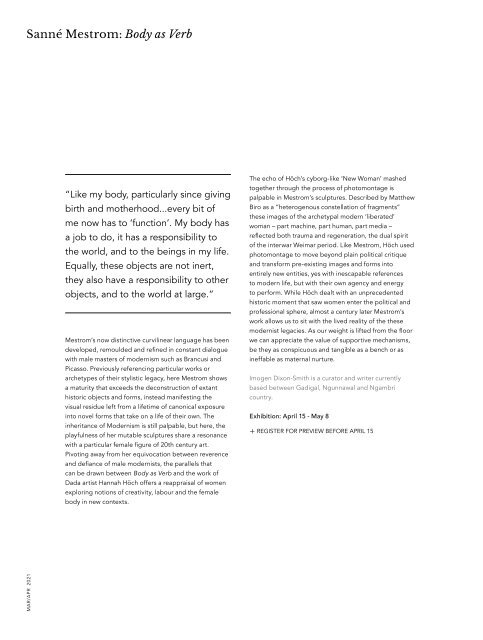Sullivan + Strumpf
You also want an ePaper? Increase the reach of your titles
YUMPU automatically turns print PDFs into web optimized ePapers that Google loves.
Sanné Mestrom: Body as Verb<br />
“Like my body, particularly since giving<br />
birth and motherhood...every bit of<br />
me now has to ‘function’. My body has<br />
a job to do, it has a responsibility to<br />
the world, and to the beings in my life.<br />
Equally, these objects are not inert,<br />
they also have a responsibility to other<br />
objects, and to the world at large.”<br />
Mestrom’s now distinctive curvilinear language has been<br />
developed, remoulded and refined in constant dialogue<br />
with male masters of modernism such as Brancusi and<br />
Picasso. Previously referencing particular works or<br />
archetypes of their stylistic legacy, here Mestrom shows<br />
a maturity that exceeds the deconstruction of extant<br />
historic objects and forms, instead manifesting the<br />
visual residue left from a lifetime of canonical exposure<br />
into novel forms that take on a life of their own. The<br />
inheritance of Modernism is still palpable, but here, the<br />
playfulness of her mutable sculptures share a resonance<br />
with a particular female figure of 20th century art.<br />
Pivoting away from her equivocation between reverence<br />
and defiance of male modernists, the parallels that<br />
can be drawn between Body as Verb and the work of<br />
Dada artist Hannah Höch offers a reappraisal of women<br />
exploring notions of creativity, labour and the female<br />
body in new contexts.<br />
The echo of Höch’s cyborg-like ‘New Woman’ mashed<br />
together through the process of photomontage is<br />
palpable in Mestrom’s sculptures. Described by Matthew<br />
Biro as a “heterogenous constellation of fragments”<br />
these images of the archetypal modern ‘liberated’<br />
woman – part machine, part human, part media –<br />
reflected both trauma and regeneration, the dual spirit<br />
of the interwar Weimar period. Like Mestrom, Höch used<br />
photomontage to move beyond plain political critique<br />
and transform pre-existing images and forms into<br />
entirely new entities, yes with inescapable references<br />
to modern life, but with their own agency and energy<br />
to perform. While Höch dealt with an unprecedented<br />
historic moment that saw women enter the political and<br />
professional sphere, almost a century later Mestrom’s<br />
work allows us to sit with the lived reality of the these<br />
modernist legacies. As our weight is lifted from the floor<br />
we can appreciate the value of supportive mechanisms,<br />
be they as conspicuous and tangible as a bench or as<br />
ineffable as maternal nurture.<br />
Imogen Dixon-Smith is a curator and writer currently<br />
based between Gadigal, Ngunnawal and Ngambri<br />
country.<br />
Exhibition: April 15 - May 8<br />
+ REGISTER FOR PREVIEW BEFORE APRIL 15<br />
MAR/APR 2021

















